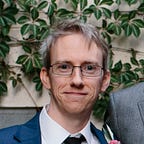Creating Blue Dust #6
Blue Dust is a sci-fi audio fiction series that I created and released in 2022. It tells the story of a teenager named Max returning to his old home, a floating mega-city, to find his father and get his old life back. You can listen on any major podcasting platform, or at https://anchor.fm/blue-dust
This blog post will focus on developing the story of Blue Dust through the connections between characters.
As I’ve previously written, Blue Dust was originally called Plus 7, and the emphasis was on plot rather than character. Through reading dozens of books on how to plan and write compelling fiction, in particular Wired For Story by Lisa Cron, however, I came to understand the importance of characters creating the story through their actions, with their actions being influenced by their personalities. In this way, a character’s action become inevitable; there would be no other way that they, as a person in the world, could act. And since characters (i.e people) are flawed and full of misconceptions, there will inevitably be drama, wrong turns and tensions.
I also understood that it was important to develop what I call a “lack,” a hole, sometimes barely visible, at other times gaping, in a character’s understanding of themselves and their place in the world. Sometimes this lack can be a flawed or faulty assumption. Sometimes it’s a fiction – usually a lie — they have been telling themselves. Sometimes it’s a blindness to face up to reality. Throughout the story, the character will work through this “lack,” usually haltingly, indirectly, or at times painfully, since it’s hard to come to terms, let alone, change one’s way of dealing with the world.
Of course characters aren’t limited to one “lack.” Max has a few, but digging down, or perhaps zooming out to get a wider angle, it’s clear that Max’s problems are intertwined and have a singular root cause. In Max’s case, his main “lack” is that he is selfish. A selfish person, by definition, puts themselves above others. When Max goes out to junk drops to ostensibly look for supplies for himself to get back to the city, he’s being selfish. When he rats out Tom as the “pheron hoarder,” to ensure his ticket back to the city, he’s being selfish. When he can’t bring himself to tell the truth to Tom in the compound, he’s being selfish.
Given Max’s selfish “lack,” I brainstormed ways to punish him. My thinking went something like this:
Q: What would a selfish person hate?
A: Being forced to care for someone (Tom). Being forced to rely on others for help (Annie, Thragh, Trigs, Vertov).
Q: How might someone justify their selfishness?
A: As “survival.” As trying to gain power and control in a cruel world.
Q: So, how can I strip Max of power and control?
A: Making his secrets public (Annie, Vertov, Thragh). Forcing him to stay in one place (at the vault, in the compound).
…and so on. By doing this, I can come up with new ideas, all based around a Max’s personality.
Max has other “lacks” as well, such as him having a too-rosy memory of his father and his old life in the city. Mostly, though, it’s Max’s selfishness that causes him to act, and just as importantly, react, in the way that he does.
I also tried to intertwine the connections between the main characters in Blue Dust. Similar to the Q&A above, I would ask a questions, then brainstorm solutions for how to make that happen. Many times I spent thousands of words answering hypothetical questions, such as “What would happen if Tom was Max’s brother?” many of which, like this one, never made it into the final script. Sometimes these questions would lead to others, and to still others, and eventually entire new modes of thinking about the story could be generated.
As well as coming up with character connections, this was a great tool for stories ideas and for breaking writer’s block. Usually writer’s block isn’t that a writer has nothing to write about at all. Instead, a writer is blocked on a particular pathway, or set of pathways. By asking far-out questions, like the one about Tom being Max’s brother above, new mental pathways can be unlocked, and the spell of feeling blocked can be broken.
Many of the connections between characters were creating in this way, including connections as fundamental as Max and Annie being siblings, Vertov and Trigs being siblings, Thragh knowing Vertov and Max’s father, and many, many more. Although I never had a graph — I don’t work well with diagrams — I always kept mental notes of the connections between characters.
Unless I can think of other topics, this will be the last blog post about creating Blue Dust. I think I’ve covered the major areas, including the initial creation, writing and production stages. If anyone hasn’t yet listened to the episodes, I apologise for spoiling some of the story details, and I would recommend checking Blue Dust out. As you can likely tell from these blog posts, it’s one of the highest achievements of my life so far and I’m very proud of it.
Thank you for reading
